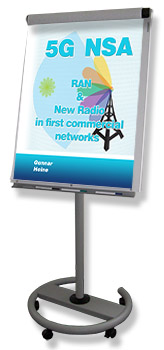 5G NSA: RAN & New Radio in first commercial networks
5G NSA: RAN & New Radio in first commercial networks
[2.5-day course, Euro 2,350.- (net) per participant]

Chapter 1: 5G in a Nutshell (1 – 2 h)
- Timeline of 5G: NSA / SA / Phase 1 and Phase 2
- General Network Topology for 5G: gNB-CU, gNB-DU, virtualization, network slicing, stand-alone vs. non-stand-alone, mMIMO
- 5G-services: eMBB, URLLC and mMTC
- EN-DC: Dual-Connectivity, Multi-Connectivity, EN-DC, NGEN-DC and NE-DC
- NSA: Option 3x vs Option 3 and 3a, other Options
- Network Architecture with NS
- Main Changes in the Radio
- Voice in 5G: VoNR, Vo5G
Chapter 2: Digging Deeper into NR (4 - 5 h)
-
Frequency Ranges: FR1 < 1 GHz, 1 GHz – 6 GHz, FR2 > 24.25 GHz Transmission bandwidth, FFT-size, subcarrier spacings, guard bands
-
Paving the way to the 5G NR:
Reviewing OFDM-Properties with LTE / LTE-A: Radio frame, subframe and slot, TTI, cyclic prefix, achievable performance in LTE -
Details of the different Numerologies:
F-OFDM Confguration with Δf = 15 kHz
From Δf = 15 kHz to Δf = 30 kHz, Δf = 60 kHz, Δf = 120 kHz and Δf = 240 kHz Summarizing the Numerologies -
Frequency Bands and their Characteristics
Example 1 < 1 GHz: Bands N5, N28: Channel Raster, GSCN, No of RB’s, max performance, etc.
Example 2 < 6 GHz: Bands N78: Channel Raster, GSCN, No of RB’s, max performance, etc. Example 3 > 24.25 GHz: Bands N258, N260: Channel Raster, GSCN, No of RB’s, max performance
Example 3 > 24.25 GHz: Bands N258, N260: Channel Raster, GSCN, No of RB’s, max performance
-
Frequency planning for 4G / 5G EN-DC operation in different parts of the world (APAC, EU, Americas)
-
Sweeping beams: mitigating the high attenuation of 3.X GHz (only introduction with animation, details in chapter 4)
-
5G TDD-operation in 3.4 – 3.7 GHz (e.g. time sharing UL/DL) / Constraints of TDD-operation (e.g. network layout, receive transmit transition time, ...)
-
Operation in FR2: Propagation Models, typical deployment scenarios in UE and network
-
Concept of BWP
-
EN-DC Band Combinations: Intra-band contiguous, Intra-band non-contiguous, Inter-band EN-DC FR1, Inter-band EN-DC FR2, Inter-band EN-DC FR1+FR2, Inter-band FR1+FR2, each with examples and use cases
-
Slot Format and dynamic TDD: D / U / F-symbols, relationship between cell size, subcarrier spacing and number of F-slots
-
Channels & Signals with 5G NR:
Logical Channels: BCCH, PCCH, CCCH, DCCH, DTCH
Transport Channels: RACH, UL-SCH, BCH, PCH, DL-SCH
Physical Channels: PBCH, PDCCH, PUSCH, PDSCH, PUCCH, PRACH Physical Signals: PSS & SSS, CSI-RS, DM-RS, PT-RS, SRS
The Concept of Quasi-Collocation -
The SS-Block (Synchronization Signal and PBCH-block) Time and frequency dimension, content, zoom in
-
New FEC: LDPC and Polar Codes: From Data Bits to Encoded Bits, Performance Comparison (BER vs SNR) for different FEC-technologies
Chapter 3: Operation (3 – 4 h)
-
Cell Search Procedure in 5G Stand-Alone:
The Grid: Synchronization Signals and PBCH in LTE vs NR
SS-Block: How to determine the time and frequency positions, repetitions, PointA, Constraints of the SS-Burst Set: No of SS-blocks, Case A-E, The Synchronization Raster or how to determine on which Frequencies to look for SS-Blocks -
Differences in cell search between SA and NSA
- Beamforming of SS-Blocks: Operation and Constraints, Dependency of number of beams with FR1 / FR2
- Link budget in 5G
- Reading and interpreting the Contents of the MIB
-
Resource Allocation in 5G
From BWP to search spaces and CORESETs.
DCI 0-0 – DCI 2-3: Meaning and tasks - Random Access procedure in 5G
Msg1 – Msg 4
Differences to 4G - Hybrid ARQ in 5G
Downlink HARQUplink HARQ
Chapter 4: mMIMO (2 h)
-
Reviewing SISO, SIMO, MISO and MIMO
-
What is mMIMO?
-
Beamforming and Beam Sweeping and how they work
-
One-Dimensional Beamforming (horizontal) vs. Two-Dimensional Beamforming (horizontal + vertical)
-
Real-life antenna constructions for mMIMO
Example 1: Real-Life Antennas with 2, 4 and 8 Antenna Ports Example 2: Real-Life Antennas with 16 Antenna Ports Example 3: Real-Life Antennas with 32 Antenna Ports Example 4: Real-Life Antennas with 64 Antenna Ports -
Use Cases and Usefulness:
=> of different Antennas
=> of two-dimensional beamforming
Chapter 5: Architecture & Protocol Stacks (1 h)
- 5G Network Architecture
- User Equipment
- NG-RAN
- NGC
-
>More Details on the 5G RAN
gNB-CU and Functional Split
gNB-DU
F1-Interface: F1-AP-protocol, SDAP-protocol - Functional Split inside gNB-DU through eCPRI eCPRI-Split Options
... and their pros and cons
eCPRI protocol stack -
Protocol Stacks Control Plane
User Plane
Protocol Stacks in Uu-, Xn- and N2/N3-interfaces - Details of the NGC
Various network functions (e.g. AMF, UPF, SMF, NSSF, ...) Virtualization
Network Slicing
Chapter 6: Higher Layer Operation (2 – 3 h)
- Overview: The UE’s way in and out of 5G with NSA
- Options: When to display 5G icon on the UE-display?
- Detailed Analysis of Scenario SgNB-Addition
=> Part 1: Attachment to the MeNB
=> Part 2: UE Radio Access Capability Transfer (with 5G and MRDC-specifics) => Logfile Analysis: Extract of Containers: UE-NR-Capability and RF-Parameters => Logfile Analysis: Extract of Container: UE-MRDC-Capability
=> Logfile Analysis: RRC_CONN_RECONF with NSA-assistance information
=> Part 3: Measurement Report from the UE to indicate 5G cell
=> Part 4: SgNB Addition through RRC_CONN_RECONF
=> Logfile Analysis: RRC_CONN_RECONF
=> Part 5: Cell Activation< - Detailed Analysis of Scenario SgNB-Modification
- Detailed Analysis of Scenario SgNB-Release
v1.000
ℹ️ Try out the updated search below!
Search:
More Info:
General Information about this course
Schedule of this training course
Buy this book
Our Training-Catalog
GSM Training Courses
(E)GPRS Training Courses
3G Training Courses
Multimedia & TCP/IP Training Courses
SS7 Protocol Stack Training Courses
Transmission & Access Technologies Related Courses
Bootcamps
